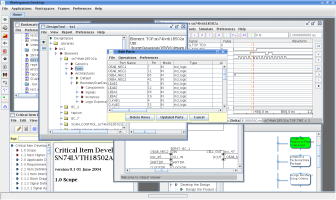Workspaces Desktop
Getting Started To run Workspaces Desktop you must
purchase a subscription at our on-line store.
A subscription lets you download, use the tool, and get updates for 1 year. After that period, you retain and can continue to use
the last version you downloaded.
To run Workspaces Desktop you must
purchase a subscription at our on-line store.
A subscription lets you download, use the tool, and get updates for 1 year. After that period, you retain and can continue to use
the last version you downloaded.
Workspaces Desktop is a program that requires Java to be installed on your computer. See the Install Page for detailed computer requirements on that and other optional third-party software you may wish to pre-install.
Once you subscribe, you will be emailed your initial login password. You can change your password at any time. At the eightolives Login page enter your email address, which is your user name, your password and select the Workspaces tool to start the software.
If you need help in getting started, you can email our Help Desk at help@eightolives.com.
Many integrated tools in one
Workspaces Desktop is an environment of tools to capture and analyze a digital system.
Things you can do
- Wizard a Sandbox and Project for your new or existing design that's ready for simulation
- Input files of type .vhd, .edf, .bsd, .sdf, .ucf, .mdl, .vcd, .js, .rss
- Navigate the design tree and edit the design
- Trace and examine ports and signals
- Create a schematic of your design
- Automatically create a simulatable model from a BSDL file
- Create timing diagrams that can generate VHDL stimulus and checkers
- Easily merge non-homogeneous components
- Group or flatten design elements
- Create documentation with a click, templates that include your design info. Templates include: Requirements Document, Interface Document, Design Description Document, Stress Chart, Verification Plan, Verification Report.
- Simulate the design
- Perform Clock Domain Analysis on multi-clock designs
- Perform Power Domain Analysis on multi-voltage designs
- Script interactively with Javascript accessing the tool and design APIs
- View, filter, edit vcd files
- Create various types of VHDL shells or wrappers
- Scale sdf delays for min, typical ad max
- Create configuration files, compile and simulation scripts
- Make a testbench
- Create, import, review and trace requirements to the design and to verification plans and reports
- GUI Interface to Gnu Privacy Guard (gpg) for file encryption / decryption
- Track design bugs / action items
- Bookmark your designs for easy access
- Track your workflow steps
- Manage team communication support
- Create inventory and parts lists for your project's designs.
- Interface to external boundary scan chains using an optional eightolives USB Interface Pod.
The Tools
- Design Tool - Input and Operate on the design
- Schematic - Create a schematic of your design, create netlists and symbols.
- Waveform Viewer - Simulate the design, draw timing diagrams, create stimulus and checkers
- Command Processor - Interactive Javascript accesses the tool's and design's APIs. Roll your own scripts.
- Inventory - A parts and parts list management tool.
- RequirementsTracker Tool - Create and manage requirements, verification plans and other documents
- ProcessTracker - Trace and status your workflow following the process
- BugTracker - Monitor your bugs, action items and things to do
- TeamTracker - Manage team email addresses, info
- GPG Services - Menu interface to Gnu Privacy Guard (gpg) for file encryption, decryption and signing
- Bookmarks - Bookmark links to your various designs and projects. Links to help, tutorials and resources.
- Editor - A simple, plain text editor
- HTML Viewer - A simple HTML viewer (external browser selectable)
- Seminar - A graphic viewer (jpeg, gif, png) with some .smi support for slide shows
- Boundary Scan Tool - A link to external IEEE 1149 hardware chains using an optional USB Interface Pod.
Features
- It's a Java program that can run on both Windows or Linux systems
- Works stand-alone, distributed from your central server or from eightolives.com
- Server's .ini file can set default parameters for local resources and templates
- Each sandbox or project can specify unique project defaults in the local project file.
- Users can edit preferences from the main menu.
- Each tool has links for Help, Tutorials and Known Problems
- Bookmarks tool has links to other help, examples and resources
